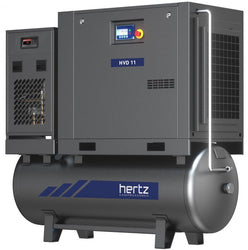Water in compressed air
Solving moisture problems in compressed air systems
Water in compressed air lines is a major problem that must be controlled. When combined with the oxygen present in the compressed air, water can create rust in piping and components. This rust destroys...
Water in compressed air lines is a major problem that must be controlled. When combined with the oxygen present in the compressed air, water can create rust in piping and components. This rust destroys the integrity of mating metal surfaces and can flake off and be carried downstream as an abrasive contaminant to create other serious problems.
Water will also displace any lubrication from bearing surfaces and cause accelerated wear. Knowing what causes a water problem, as with most things, will give you a head start in controlling it.
One of the major differences between a gas (air) and a liquid (water or oil) is that a gas can be compressed or squeezed into a smaller space (not so with a liquid). The gas, when squeezed into this smaller space, increases its pressure, which usually is measured in pounds per square inch (psi). If you took eight cubic feet of the air around you and stuffed it into a one cubic foot container, the resulting pressure would be about 100 psi (it’s actually 103 psi but you would probably spill some in the process so we’II call it 100 psi).
That air, however, contains moisture in the form of humidity that cannot be compressed.
Humidity
Humidity is a measure of the air’s ability to absorb water. A measure of 100% humidity represents the maximum amount of moisture that air can hold on to before it starts to “rain.” This ability to hold on to moisture is affected by temperature. The hotter it gets, the more water the air is capable of hanging on to. In fact, for every 20F (10C) rise in temperature, the ability of air to hold on to water doubles. The reverse also is true.
For example, if air at 50% humidity and 90F was cooled to 70F (a reduction of 20F), the resulting humidity level would be 100%. The air could only hold on to half as much water, therefore the former 50% humidity level would now represent 100% of the air’s ability to hold on to the water that was in it.
The temperature at which the air’s humidity is 100% is the dew point of that air. In this case, the dew point would be 70F. An interesting note is that by lowering that temperature to 69F, it would start to rain.
More heat
When air is compressed, its molecules, which are always moving and colliding against each other, are squeezed closer together. This causes them to collide more often, thereby creating more heat. In fact, the outlet temperature from the average air-cooled compressor operating at 100 psi can reach as high as 350F to 400F.
Now, go back to the first example using the 8 cu ft squeezed into 1 cu ft and apply some of these new rules. Assume that the humidity level of the air is 50% and the temperature is 70F. When the 8 cu ft of air is compressed to 4 cu ft, the suspended water, or humidity, will not compress and thus represents a greater percentage (100%) of the smaller volume (4 cu ft). Similarly when you squeeze the 4 cu ft to 2 cu ft, the resulting humidity is 200%. Compression from 2 cu ft to 1 cu ft would result in a final humidity level of 400%.
Rain inside the compressor?
Since air, compressed or not, can only support a 100% humidity level, we might assume, then that it is raining inside the compressor. This, of course, is not the case because of the high temperature created by compression.
If we look at the effect of temperature on the previous example, we find that the 400% humidity is reduced to 200% when the temperature is raised from 70F to 90F and then to 100% by further raising the temperature to 110F. Thus, we can see that relative humidity is related to temperature as well as the moisture content of the air. We can also see why atmospheric air at 70F and 50% humidity (a dew point of 50F) will have a dew point of 110F at 100 psi.
Is it then true to say that if our atmospheric air at 70F was at 100% humidity, the resulting dew point at 100 psi would be 130F? Yes, that’s right.
You can use this same logic to explain what happens when you breath on a cold window pane or why the cold water pipes drip water on your basement floor in the summer but not in the winter. Perhaps a more pertinent question is why the water problem in your plant’s compressed air system is so bad in the summer and yet seems to disappear in the winter.

